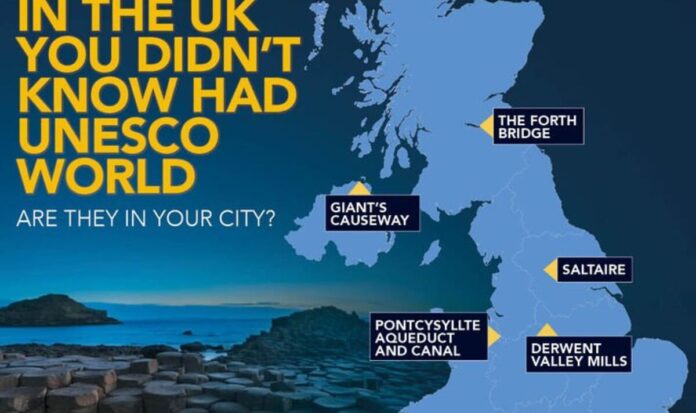In the wake of the bloodshed and suffering incurred throughout the successive World Wars which each shook the globe, the United Nations Educational, Scientific and Cultural Organisation (UNESCO) was born. Its mission: to champion peace through international cooperation in the three areas named in its title. In a large, bustling conference hall 77 years ago, on November 16, 1945, 37 countries signed the Constitution of UNESCO. Now, it has more than 190 members with 1,154 world heritage sites across the globe. Within the UK alone, there are 33 sites that are thought to be of ‘Outstanding Universal Value’. Express.co.uk takes a look at those which make the grade that might just surprise you.The Derwent Valley Mills sits along the River Derwent in Derbyshire. It contains a series of 18th and 19th-century cotton mill complexes. The ‘father of the modern industrial factory system’, Richard Arkwright, developed his yarn at his mill in Cromford which is now part of the site.2. Heart of Neolithic Orkney (1999) The site is made up of Neolithic monuments on Northern Scotland’s archipelago, Orkney, which has a population of more than 22,000 people. The monuments consist of Maes Howe, a large chambered tomb, the ceremonial stone circles Ring of Brodgar and Stones of Stenness, and the settlement Skara Brae. 3. Maritime Greenwich (1997)Lying on the banks of the River Thames in South East London, Maritime Greenwich consists of the first Palladian (or 17th century) building in England, The Queen’s House, The Royal Naval College, and the Old Royal Observatory, home of Greenwich Mean Time. There are 9 surprising UNESCO sites found in the UK (Image: Express / Getty) The Derwent Valley Mills in Derbyshire is home to former cotton mill complexes (Image: Getty) The Ring of Brodgar is one of the Neolithic monuments on Northern Scotland’s archipelago, Orkney (Image: Getty)First opened in 1890, when it was then the world’s longest railway bridge stretching for 1.5 miles, the iconic Forth Bridge in Edinburgh is known for its bright red colour. It was covered in thousands of gallons of special paint and finally finished in 2012, more than 120 years after it was first built. Thanks to the continuous work required to maintain its bright red colour, the structure is often used within a phrase to describe a task that will never be complete. 5. Pontcysyllte Aqueduct and Canal (2009) Many of the UNESCO sites in Wales celebrate the country’s industrial heritage. The Pontcysyllte Aqueduct and Canal, completed in the early 19th century, stretches for 18 kilometres. Described as a ‘masterpiece of engineering and monumental metal architecture’, the crossing made transporting goods from Wales to England easier. In South Wales, Blaenavon Industrial Landscape, added to the UNESCO list in 2000, was home to the first major producer of iron and coal in the world. Last year, the Slate Landscape of Northwest Wales was named an important cultural landscape thanks to its production of roof slates. By the end of the 19th century, one-third of all the world’s slates were manufactured there.READ MORE: Britain’s favourite attractions named – ‘breathtaking’ Martitime Greenwich’s Old Royal Naval College in London (Image: Getty) The Forth Bridge in Scotland first opened in 1890 (Image: Getty) Pontcysyllte Aqueduct in Wales was built in the early 19th century (Image: Getty) Saltaire Mill on the and the River Aire, Yorkshire (Image: Getty) Durdle Door, one of Dorset’s most popular landmarks (Image: Getty) Bath’s Royal Crescent is a popular location for filming period dramas (Image: Getty)Another natural site in Northern Ireland on the UNESCO list is Giant’s Causeway, often described there as the 8th Wonder of the World. It is made up of around 40,000 black basalt columns created approximately 6 million years ago. Its name is thought to derive from the legend that giants would head to Scotland by striding over the sea. 9. City of Bath (1987)Bath was listed as a UNESCO cultural site thanks to it being home to the likes of Roman remains and hot springs which can be visited at Thermae Bath Spa, first opened in 2006. The South Western city now boasts approximately 5,000 listed buildings such as the Royal Crescent, a row of terraced houses built between 1767 and 1775. It is often used for filming period dramas. For example, it features in the 2008 film The Duchess starring Keira Knightley. Bath is the only city in the UK to be deemed a World Heritage Site in its entirety. Liverpool’s waterfront was given the UNESCO heritage site title in 2004, but it was stripped of this last year following a series of developments. The Old and New Towns of Scotland’s Edinburgh also feature on the UNESCO list.
9 surprising places in the UK that have UNESCO world heritage status
Sourceexpress.co.uk
RELATED ARTICLES


